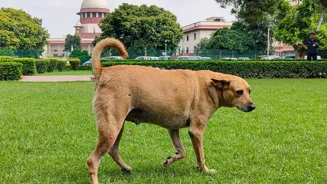The three-judge Bench of the Supreme Court, by staying the earlier order of a two-judge Bench and putting its stamp of validity on the ubiquitously Indian phenomenon of community or street dogs, has not
only upheld the law again but also reiterated faith in the wisdom of Indian culture. Following the time-tested wisdom and practices of our forebears rather than succumbing to the perceived “superior” sagacity of the West is truly an imperative now.
Even before Friday’s judgement upholding the efficacy of vaccinating, sterilising and releasing dogs back to their own territories as the only practical and humane way of dealing with the stray issue (rather than using the slanted word “menace”), there have been times when India has struck a different path from the West on animals. The most visible of these was the landmark Wildlife Protection Act, passed in 1972 which totally banned all forms of hunting.
Criticism ranged from the Act making it a wildlife vs human situation with the latter prevailing thereby making it tough to “deal with dangerous animals” to even calling it “Brahmanical” as it outlawed traditional livelihoods of snake charmers and bear and monkey dancers. But the fact remains that despite huge population pressure, India has managed to protect most of its wildlife thanks to this Act, though the success of Project Tiger is the most eye-catching.
India refused to see its wild animals as “resources” to be utilised to bring in the blood-soaked dollars of “trophy” game hunters, unlike some African countries. India was not swayed by the self-serving, specious logic proffered by Western nations that it is ethically justifiable to sacrifice a few lions, giraffes, cheetahs, elephants etc to pay for the “conservation” of the rest. India saw the hypocrisy in promoting blood sport in the same breath as conservation.
The same “animal rights” spewing West thinks nothing of “culling” as a solution too, ruthlessly killing hundreds of thousands of bears, wolves, coyotes, beavers, otters, kangaroos, wallabies, camels over the decades–any animal they perceive to be inimical to the interests of agriculture and human habitations. They clearly believe no animal, wild or domesticated, has a right to exist except on sufferance though the West has far less people per sq km than India.
And China—the country the West fears and secretly admires—has the dubious distinction of trying to wipe out the entire sparrow population just because Mao Zedong decided they were one of the “Four Pests” to be eradicated as part of a campaign to curb disease. The other three were rats, mosquitoes and flies, but sparrows were singled out among birds because they allegedly ate too much grain. Ironically this “sparrowcide” led to the 1959-61 famine.
According to reports of the time, within the first few months, 300 million rats and sparrows were killed as also 4.54 million boxes of mosquitoes and flies, and over ten times as many boxes of fly larvae initially. By the end of the first year, the government claimed 1.9 billion rats, and 2 billion sparrows were killed; and the next year, another 1 billion sparrows, 1.5 billion rats, 100 million kg of flies, and 11 million kg of mosquitoes were supposedly exterminated.
Much worse was the indoctrination in schools, motivating children as young as five to go out and kill sparrows. Entire schools were sent out to hunt them, destroy their nests, chicks and eggs, and not let them rest on trees even at night. Think of the distortions that such cruel, disruptive actions perpetrated on young minds. Ultimately sparrows were replaced by bedbugs in the Four Pest list by Mao but the damage was done: there was a devastating effect on crops.
Ignoring the logic of the animal kingdom being a delicate balance of species cost China very dear. The near-extermination of sparrows (though billions are hard to verify) led to an explosion of insects, particularly locusts, which wreaked havoc on food grain crops, causing famine and stopping Mao’s Great Leap Forward in its tracks. Poetic justice. But sadly, 85 years after that failure, the same sort of sentiment was sought to be whipped up over stray dogs in India.
Apart from the lessons to be drawn from the ecological and economic effect of China’s sparrowcide failure, India has the unique benefit of being the only country whose majority religion reserves a special place for animals in its pantheon, unlike the Abrahamic faiths that dominate the rest of the world. India’s Gods have animals as their companions, including dogs, so there is a millennia-old philosophy for lawmakers and judges to draw on for guidance.
The cruelty and impracticality of permanently incarcerating (and thereby killing via slow starvation and neglect) the entire ‘stray’ segment of canis lupus familiaris — dogs—had escaped the comprehension of far too many people. In a world where humans in institutional “care” whether prisoners, the elderly, orphans, destitutes or mentally ill are treated abysmally, condemning animals to similar fates should have horrified many more than it actually did.
The events of the last fortnight are uncomfortably reminiscent of those Chinese children who rejoiced at the idea of killing millions of little birds and destroying their habitats, ignoring science, logic and basic compassion for other living beings. Judging by the actions of some segments of society, it almost seemed like India could also reach that same level of depravity, ignoring the longstanding reverence for all animals ingrained in the majority faith.
Luckily for India, the three judge SC Bench has brought law, practicality and compassion back into the discourse by passing a fair interim order that needs the mutual cooperation of the authorities, residents and animal welfare activists. Most importantly, by ordering that stray dogs must be released after vaccination and sterilisation back in their original areas, the Court has underlined their right to live freely in open spaces, which is a profound article of faith.
Although only an interim order as yet, there is hope that the judges will keep in mind the weight of India’s millennial respect for all life, a live-and-let-live ethos that encourages companionship between humans and animals in all strata of society when deliberating on the final verdict that will be binding on the entire country. The interconnectedness of all living things on our planet, no matter how humble, is a truth that none of us can afford to deny or forget.
The author is a freelance writer. Views expressed in the above piece are personal and solely those of the author. They do not necessarily reflect News18’s views.















